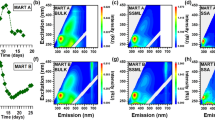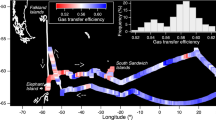Abstract
Sea spray facilitates the movement of matter and energy between the ocean and the atmosphere. While many of its contributions to heat and momentum transfer are relatively well understood, the contribution to chemical exchange, particularly gas exchange, remains less well known. This study provides an estimation of sea-spray gas-exchange potential for five gases (helium, neon, argon, oxygen and nitrogen) using a chemically modified microphysical model, the Andreas Gas Exchange Spray model. This model uses the physical evolution of the sea-spray droplet and gas-exchange equilibria to estimate the potential exchange of gases attributable to spray droplets. We find that sea spray does not contribute appreciably to gas exchange of helium and neon. However, for argon, oxygen and nitrogen, at high wind speeds (above 18 m s–1), sea-spray-droplet-facilitated exchange could contribute substantially to gas flux and is on the same order of magnitude as the empirically constrained direct exchange across the interface. Sea spray, as a potential pathway for atmosphere–ocean gas exchange, may improve gas-exchange predictions in the high-wind scenarios that are particularly important in the Southern Ocean polar region.
This is a preview of subscription content, access via your institution
Access options
Access Nature and 54 other Nature Portfolio journals
Get Nature+, our best-value online-access subscription
$29.99 / 30 days
cancel any time
Subscribe to this journal
Receive 12 print issues and online access
$259.00 per year
only $21.58 per issue
Buy this article
- Purchase on Springer Link
- Instant access to full article PDF
Prices may be subject to local taxes which are calculated during checkout





Similar content being viewed by others
Data availability
Data used in the analysis were obtained from publicly available sources as cited. Temperatures were obtained from the ICOADS dataset, which asks that we acknowledge by including the statement “ICOADS data provided by the NOAA/OAR/ESRL PSD, Boulder, Colorado, USA, from their Web site at http://www.esrl.noaa.gov/psd/.” Air and sea temperatures were downloaded from the ICOADS long-term monthly mean products through https://icoads.noaa.gov/data.icoads.html and processed for the regions shown in the Methods. Salinity was averaged from the ranges presented by Emery and Meincke29. Seawinds QuikSCAT data were obtained from https://podaac-opendap.jpl.nasa.gov/opendap/allData/quikscat/L3/wind_1deg_1mo/ and filtered for January and July of all available years. Data generated using the AGES model are also available through OSF: https://doi.org/10.17605/OSF.IO/6AUWS. Source data are provided with this paper.
Code availability
All code used in the AGES model has been deposited in the Open Science Framework: https://doi.org/10.17605/OSF.IO/6AUWS.
References
Woodcock, A. H., Kientzler, C. F., Arons, A. B. & Blanchard, D. C. Giant condensation nuclei from bursting bubbles. Nature 172, 1144–1145 (1953).
Blanchard, D. C. Bursting of bubbles at an air–water interface. Nature 173, 1048 (1954).
Blanchard, D. C. The electrification of the atmosphere by particles from bubbles in the sea. Prog. Oceanogr. 1, 71–202 (1963).
O’ Dowd, C. D. et al. Biogenically driven organic contribution to sea spray aerosol. Lett. Nat. 431, 676–680 (2004).
Monahan, E. C. & O’Muircheartaigh, I. G. Whitecaps and the passive remote sensing of the ocean surface. Int. J. Remote Sens. 7, 627–642 (1986).
Monahan, E. C. Spiel, D. E. & Davidson, K. L. in Oceanic Whitecaps and Their Role in Air–Sea Exchange Processes (eds Monahan E.C. and Mac Niocaill, G.) 167–174 (Kluwer Academic, 1986).
Lewis, E. R. & Schwartz, S. E. Sea Salt Aerosol Production: Mechanisms, Methods, Measurements and Models: A Critical Review (American Geophysical Union, 2004).
Andreas, E. L., Edson, J. B., Monahan, E. C., Rouault, M. P. & Smith, S. D. The spray contribution to net evaporation from the sea: a review of recent progress. Bound.-Layer Meteorol. 72, 2–52 (1995).
Andreas, E. L. A new sea spray generation function for wind speeds up to 32 m s–1. J. Phys. Oceanogr. 28, 2175–2184 (1998).
Monahan, E. C., Staniec, A. & Vlahos P. Spume drops: their potential role in air–sea gas exchange. J. Geophys. Res. Oceans https://doi.org/10.1002/2017JC013293 (2017).
MacIntyre, F. Flow patterns in breaking bubbles. J. Geophys. Res. 77, 5211–5228 (1972).
Quinn, P. K. et al. Contribution of sea surface carbon pool to organic matter enrichment in sea spray aerosol. Nat. Geosci. 7, 228–232 (2014).
Masterton, W. L. Salting coefficients for gases in seawater from scaled-particle theory. J. Solution Chem. 4, 523–534 (1975).
ICOADS 2° × 2° Long-Term Monthly Mean Products (NOAA/OAR/ESRL PSD, accessed April 2021); http://www.esrl.noaa.gov/psd/
Anguelova, M., Barber, R. P. & Wu, J. Spume drops produced by the wind tearing of wave crests. J. Phys. Oceanogr. 29, 1156–1165 (1999).
Stanley, R. H. R., Jenkins, W. J., Lott, D. E. III & Doney, S. C. Noble gas constraints on air–sea gas exchange and bubble fluxes. J. Geophys. Res. 114, C11020 (2009).
Libes, S. Introduction to Marine Biogeochemistry (Elsevier, 2009).
Wanninkhof, R. Relationship between wind speed and gas exchange over the ocean. J. Geophys. Res. 97, 7373–7382 (1992).
Sampe, T. & Xie, S. Mapping high sea winds from space: a global climatology. Bull. Am. Meteor. Soc. 88, 1965–1978 (2007).
Saunders, K. M. et al. Holocene dynamics of the Southern Hemisphere westerly winds and possible links to CO2 outgassing. Nat. Geosci. 11, 650–655 (2018).
Gray, A. et al. Autonomous biogeochemical floats detect significant carbon dioxide outgassing in the high-latitude Southern Ocean. Geophys. Res. Lett. 45, 9049–9057 (2018).
Wanninkhof, R., Sullivan, K. F. & Top, Z. Air–sea gas transfer in the Southern Ocean. J. Geophys. Res. 109, C08S19 (2004).
Young, I. R., Zieger, S. & Babanin, A. V. Global trends in wind speed and wave height. Science 332, 451–455 (2011).
World Ocean Basemap (Esri, 2021); https://go.nature.com/3BvueBT
SeaWinds on QuikSCAT Level 3 Surface Wind Speed for Climate Model Comparison Version 1 (NASA, 2012); https://doi.org/10.5067/QSSWS-CMIP1
Andreas, E. An Algorithm for Fast Microphysical Calculations that Predict the Evolution of Saline Droplets (NWRA, 2013); www.nwra.com/resumes/andreas/software.php
Sander, R. Compilation of Henry’s law constants (version 4.0) for water as solvent. Atmos. Chem. Phys. 15, 4399–4981 (2015).
Andreas, E. L., Vlahos, P. & Monahan, E. C. Spray-mediated air–sea gas exchange: the governing time scales. J. Mar. Sci. Eng. 5, 60 (2017).
Emery, W. & Meincke, J. Global water masses—summary and review. Oceanol. Acta 9, 383–391 (1986).
Andreas, E. L. Thermal and Size Evolution of Sea Spray Droplets Report 89-11 (US Army Cold Regions Research and Engineering Laboratory, 1989).
Andreas, E. L., Persson, P. O. & Hare, J. E. A bulk turbulent air–sea flux algorithm for high-wind, spray conditions. J. Phys. Oceanogr. 38, 1581–1596 (2008).
Wannikhof, R. Relationship between wind speed and gas exchange over the ocean revisited. Limnol. Oceanogr. Methods 12, 351–362 (2014).
Acknowledgements
The authors acknowledge E. Andreas for the creation of the original program26 upon which this model was built and without which this work could not be accomplished. We also acknowledge A. Bourganos for his assistance with proofing the AGES model code. Work was funded through NSF grant nos. 13-56541 (P.V. and E.C.M.) and 16-30846 (P.V. and E.C.M.).
Author information
Authors and Affiliations
Contributions
A.S. modified and coded the program used for this analysis and prepared the figures used therein. P.V. assisted A.S. in an advisory capacity and provided the calculated wind-speed volume fluxes. E.C.M. is responsible for the portions of this paper that place it in a historical context and made invaluable contributions to the comprehensive coverage of sea-spray physics. All authors contributed to the preparation of the manuscript.
Corresponding author
Ethics declarations
Competing interests
The authors declare no competing interests.
Additional information
Peer review information Nature Geoscience thanks the anonymous reviewers for their contribution to the peer review of this work.
Primary Handling Editor Rebecca Neely, in collaboration with the Nature Geoscience team.
Publisher’s note Springer Nature remains neutral with regard to jurisdictional claims in published maps and institutional affiliations.
Extended data
Extended Data Fig. 1 Global Regions.
The global regions used for this study (adapted from Emery and Meincke29).
Extended Data Fig. 2 Global Map of Helium Gas Exchange.
Potential gas exchange associated with a 100 µm sea spray droplet presented as the percentage of the initial gas volume lost to the atmosphere if the droplet reaches final radial equilibrium.
Extended Data Fig. 3 Global Map of Neon Gas Exchange.
Potential gas exchange associated with a 100 µm sea spray droplet presented as the percentage of the initial gas volume lost to the atmosphere if the droplet reaches final radial equilibrium.
Extended Data Fig. 4 Global Map of Argon Gas Exchange.
Potential gas exchange associated with a 100 µm sea spray droplet presented as the percentage of the initial gas volume lost to the atmosphere if the droplet reaches final radial equilibrium.
Extended Data Fig. 5 Global Map of Nitrogen Gas Exchange.
Potential gas exchange associated with a 100 µm sea spray droplet presented as the percentage of the initial gas volume lost to the atmosphere if the droplet reaches final radial equilibrium.
Supplementary information
Supplementary Information
Supplementary Tables 1–3.
Source data
Source Data Fig. 2
Fig. 2 Source Data.
Source Data Fig. 3
Fig. 3 Source Data.
Source Data Fig. 4
Fig. 4 Source Data.
Rights and permissions
About this article
Cite this article
Staniec, A., Vlahos, P. & Monahan, E.C. The role of sea spray in atmosphere–ocean gas exchange. Nat. Geosci. 14, 593–598 (2021). https://doi.org/10.1038/s41561-021-00796-z
Received:
Accepted:
Published:
Issue Date:
DOI: https://doi.org/10.1038/s41561-021-00796-z
This article is cited by
-
Big potential for tiny droplets
Nature Geoscience (2021)



